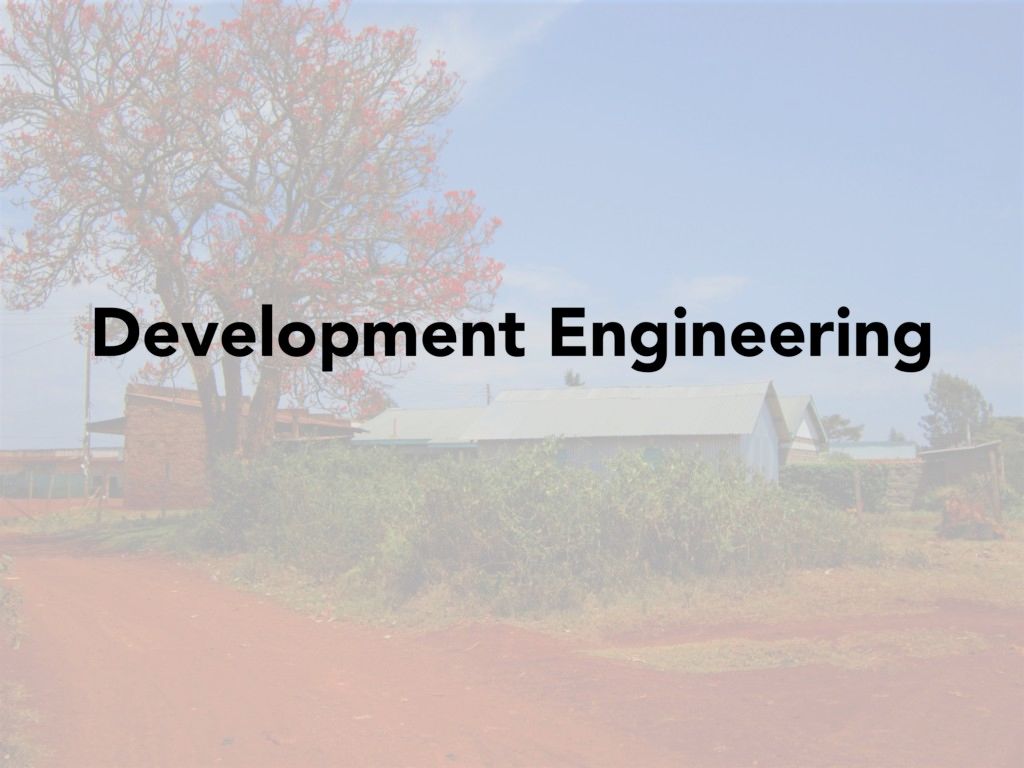
Development engineering is an emerging field that brings together communities, businesses, students, faculty, non-governmental organizations (NGOs), and governments, as well as for- and non-profit organizations, with the intention of working collaboratively to solve global challenges. It is, by design, a multidisciplinary field that bridges engineering and social sciences such as economics, public health, and gender studies and places them alongside business and entrepreneurship for societal benefit. In this piece, we’ll dive into where the new field of development engineering came from, where it’s headed, and the challenges it’s facing along the way. Development engineering has the potential to address massively complex challenges our world grapples with today, and by understanding its history and trajectory, we examine how development engineering can contribute to social change.
The history that paved the way for the emergence of development engineering, as well as the drivers behind it and the core tensions it currently wrestles with, will all be explored here from our perspective: two current PhD students in the Development Engineering program at UC Berkeley. We have seen the academic side of development engineering within the university setting as well as the entrepreneurial side, a perspective both of us have gained through running technology-based ventures in healthcare.
What development engineering is and how it’s different
Also known as “humanitarian engineering”, “engineering for change”, or “engineering for impact”, development engineering is a field of research and practice that combines the principles of engineering with economics, entrepreneurship, design, business, and policy—among others—to create technological interventions in accordance with the needs and wants of individuals living in complex, low-resource settings. While most may associate these settings with “developing” or “third world” countries, development engineering equips practitioners to work on social problems wherever they exist, whether that is California or Bangladesh. A variety of technologies have been created for diverse contexts, such as modular greenhouses for use in Kenya, a device for cervical cancer screening education in Ghana, and a filter to remove arsenic from groundwater in the United States.
Development engineering isn’t entirely new. Engineers have long been engaged in public service. The first canon of the Code of Ethics for Engineers states that “engineers shall hold paramount the safety, health, and welfare of the public.” Development engineering aims to build on the profession’s service-oriented roots by integrating both social and technical considerations into design work to ensure that proposed solutions sustain intended benefits over time. In this spirit, development engineering interventions may take the form of solutions that address systemic problems. One systemic problem addressed by development engineers is the lack of contextual consideration. For example, medical devices donated to developing countries often fail because the equipment does not match community need, no system for maintenance exists, or the user manual becomes lost. One potential development engineering project would aim to create medical devices suitable for use in a developing country, taking into account relevant factors such as required durability, power supply, and availability of spare parts.
Historically, engineering training is often deeply technical (e.g., learning fluid mechanics, thermodynamics, and advanced calculus) and places less emphasis on communication and contextual understanding. This position is generally reinforced by engineering programs and faculty that call the ability to write or give a presentation a “soft” skill. However, engineers are well-equipped to examine problems holistically—traditionally, they learn to simultaneously understand the details of a situation as well as the broader problem context. But in practice, this often manifests as understanding, for example, how the flow rates in a wastewater treatment system relate to total sediment removal, and not how a telemedicine system can change national health policy. Engineering was created as an applied science; development engineering takes it one step further by broadening the potential applications of engineering to address real-world, poverty-driven challenges.
Development engineering hinges on the understanding that creating sustainable systems around a technological intervention requires more than just engineering prowess—it requires knowledge of aspects like local economics and business to understand financial viability as well as ethnography (i.e., systematic study of people and their behaviors and culture) and interviewing practices to understand the community. While the traditional focus on “hard” skills is changing as engineering programs evolve, emphasizing the need for students to develop communication and entrepreneurial competencies is core to development engineering.
To be clear, this is not a belief that engineers should be expected to be experts in ethnography, geography, economics, and engineering. Instead, the hope is that engineers will become able to translate concepts across disciplines and understand there are many “unknown” unknowns, or factors not yet considered that must be uncovered if a technological intervention is to be successfully implemented over time.
Why development engineering is necessary
Today’s complex, globalized world is filled with problems that are messy with no clear solutions. Problems such as securing access to food in an era of climate change, providing universal housing amidst rapid urbanization, and determining ways to provide consumers with low-carbon energy sources all require innovative thinking and action if progress is to be made. As Paul Polak—a leader in the social entrepreneurship movement—states, over 90 percent of the world’s design efforts are aimed at 10 percent of the population. The people who need game-changing solutions are not engaged in the innovation process while, at the same time, significant resources are being spent on solving the wrong problems, or more precisely, developing products and processes that make money but only improve the world for a small number of people.
Unlike an engineering homework set where all the necessary information can be found in a textbook, “wicked” problems are those that are ill-defined and complex. “Wicked” problems are indeterminate and there aren’t rules for how to generate and implement solutions to them. Solving “wicked” problems requires intimate knowledge of the problem context, a point that is too often overlooked and causes initiatives that aim to implement technology within development projects to fail. If we, as a global society, are going to gain traction on solving compelling and immediate problems with complex societal and ecological dimensions, we need programs like development engineering to train the next generation of engineers to become critical thinkers and doers. Without sufficient training, students and practitioners with good intentions run the risk of failing to achieve their goals or, worse, doing more harm than good.
Consider, for example, a well-funded and publicly optimistic venture to install “PlayPumps” in Southern Africa to attempt to solve the regional water crisis. The PlayPump connects a merry-go-round contraption to a water pump that allows playing children to power a device to extract and store groundwater. However, after all the hype and tens of millions of dollars fundraised, the PlayPump installations in Mozambique and South Africa were soon inoperable. Yet in order to meet donor demands and live up to the marketing hype, PlayPumps were installed in thousands of locations, replacing the traditional water pumps already there, effectively transforming PlayPumps into a not only a failed venture, but also one that became useless and exploitative by forcing children to keep turning the merry-go-round nonstop in order to pump out enough water to meet village demand.
Instead of solving a dire water crisis, PlayPumps actually contributed to water inequities in Southern Africa by replacing the workable traditional water pumps with an exciting, but ultimately deeply flawed, water pump design. PlayPumps succinctly illustrate that global issues don’t come with quick fixes and that engineers can’t just casually step in to help with a community’s needs. Instead, global development requires a rigorous approach for which technically trained engineers need to have a better understanding of problem contexts, either through collaboration or a more rounded education.
In this vein, development engineering can add significant value to global development by providing a space for diverse parties with the same goal to connect, find collaboration opportunities, and share best practices as well as mistakes and failures. Although many practitioners may be working on the same types of projects in different settings—or working on different projects in the same setting—they aren’t always talking to one another. This communication breakdown results in mistakes frequently being repeated and redundancy of efforts. Development engineering, however, builds a more cohesive community by bringing faculty from different disciplines (e.g., business and engineering) together to co-teach core development courses and by requiring engineers to learn about public health and economics. Connection among peers happens through dedicated conferences, an open-access journal, and academic centers such as the Blum Center, which serve as hubs for meet-ups, classes, and conversations.
Where development engineering started
The roots of development engineering can be traced back to the time of colonialism and imperialism. The era preceding World War II saw Western powers in the world occupying and exploiting non-Western countries with less economic power. In the 1940s the United States instituted the Marshall Plan to provide material aid for Western European nations affected by the destruction wrought in the war, which represented the first instance of the US giving aid internationally. President Harry Truman’s inaugural address in 1949 outlined a plan to “embark on a bold new program for making the benefits of our scientific advances and industrial progress available for the improvement and growth of underdeveloped areas,” which development critic Gustavo Esteva regards as the invention of development.
With the belief that underdeveloped nations needed to be “modernized”, the 1960s saw a period of Western nations giving technologies to formerly colonized non-Western nations, assuming such technology transfer would yield fast success. After failing to see progress in the way of economic or technological “development” in the modernization era, the 1970s saw an alternative approach to aid. The rise of “appropriate” technology coincided with the growing recognition that for technology to be accepted, it needed to be designed for the intended use context. Simply transferring a technology designed for Western nations to a developing country would not yield desired progress. This new approach, which emphasized the importance of integrating contextual considerations in development, was formalized at the first Design for Development congress in 1979. The congress itself, hosted by the International Council of Societies of Industrial Design (ICSID) and the United Nations Industrial Development Organization (UNIDO), represented a crucial moment in recognizing design—a close cousin to engineering—as a tool for global development, useful in creating products and services to meet social needs. The congress also signed the Ahmedabad Declaration, formalizing a new “design for development” field.
In the 1980s and 1990s, as design and engineering became increasingly employed in socially conscious settings, the tech boom connected the world on an unprecedented scale. However, these connections created a “spiky” (unequal) world in which the urban and wealthy regions rapidly outpaced the rural and poorer areas in economic development, innovation, and general well-being. During the same time, both those working in development and intended beneficiaries became disillusioned by the power of multilateral institutions (large organizations funded by multiple nations) like the World Bank and International Monetary Fund (IMF) to promote international development and, consequently, that allowed engineers and designers to imbue small-scale and localized projects with their technical expertise.
Attempting to gain back the generally lost trust of large multinational organizations, in September 2000, the United Nations suggested eight goals “to reverse the grinding poverty, hunger, and disease affecting billions of people”: the Millennium Development Goals (MDGs). These served as a catalyst to further encourage the involvement of engineers and designers in addressing global challenges by engaging in smaller, more localized projects. More and more funding opportunities began to arise for development-oriented projects in the wake of the growing international commitment to the MDGs, and what emerged was an ecosystem that provided support to ventures, projects, and programs at the intersection of engineering and impact.
[caption id="attachment\\_14695" align="aligncenter" width="620"][](http://bit.ly/dev-eng) Image by authors. Previously published on Impact Design Hub.[/caption]
The coalescing of a movement
At universities, students and faculty began to recognize a multi-faceted opportunity. Each semester a new crop of students enrolls with time and energy to work on aspects of important and impactful problems as opposed to, for example, spending time redesigning part of a car engine. Project-based classes that started as “crazy ideas” by motivated faculty members at various universities were acknowledged as being able to provide specific opportunities for students to apply the knowledge they were learning in technical classes toward the causes that the MDGs focused on.
It doesn’t take long for the students to be hooked. For many engineers in training, the impact of participating in a project-based class focused on problems faced by real people redefined the possibility of what engineering could encompass. For universities, project-based engineering and design classes provide the training students need to become next generation of engineers who would work to address these important social issues. Support for classes and projects from funding institutions such as VentureWell, the National Science Foundation, and the United States Environmental Protection Agency helped to expand enrollment, transform classes in programs and centers, and further catalyze impact.
A major draw of these programs among students is the ability to engage with like-minded peers they otherwise wouldn’t have worked with and to connect with people whose experience of the world is vastly different from their own. Perhaps, however, the biggest appeal to students of these programs, particularly Millennials and Gen-Xers, is the belief that one’s efforts are creating real, needed impact. As one student from Penn State’s Humanitarian Engineering and Social Entrepreneurship program noted, “Many times I have wanted to make a difference, but I have never known how. Now I have the ability to change lives in a real part of the world.” While this is motivating for many students, it has had a profound influence on female students in particular, who are overrepresented in development engineering programs. The hope for programs like ours is that they will help to transform individuals’ desire to help out into an actual ability to make a sustainable difference in the lives of the intended beneficiaries.
Of course, universities are not doing this alone. An entire subset of the broader development ecosystem shares the credit for the creation and growth of the development engineering field. There are multiple types of organizations that are fusing technology with other disciplines to create products, provide financial services, and accelerate health innovation, including for-profit ventures, non-profit organizations, foundations, government agencies, and multilateral organizations. Funding agencies are also playing a key role in providing support for impact-orientedentrepreneurs and ventures at both early and middle stages. A key funder of the development engineering field was the United States Agency for International Development (USAID), whose Higher Education Solutions Network provided significant resources to grow labs at seven university campuses working to evaluate and strengthen real-world innovations for development.
[caption id="attachment\\_14696" align="aligncenter" width="620"][](http://bit.ly/dev-eng) Image by authors. Previously published on Impact Design Hub.[/caption]
The future of development engineering
Throughout its proliferation, the development engineering field has seen successes including a growing number of academic programs, increased buy-in from funding sources, and a growing base of practitioners. However, there is still much to be done as the field matures and shapes the broader development agenda. Growing pains are common in any new field or movement, but rather than ignoring them, it’s important that they’re called out in order to spur thoughtful conversations and spark action to move the field forward. Some of the central challenges facing development engineering currently include balancing academic incentives with real-world impact, fitting community-driven work into institution-driven programs, and blending techno-centric and human-centric approaches.
First, a lack of alignment often exists between academic incentives and the factors that drive real-world impact. At the faculty level, this is seen in the publication system and tenure committees. As Virginia Tech professor Marc Edwards recently wrote in Environmental Engineering Science, “The goal of measuring scientific productivity has given rise to quantitative performance metrics, including publication count, citations, combined citation-publication counts. Quantitative metrics are scholar-centric and reward output, which is not necessarily the same as achieving a goal of socially relevant and impactful research outcomes.” Few incentives exist for faculty to spend the extra effort to engage with communities and maintain diverse partnerships and relationships.
Furthermore, faculty are compared against peers who may have been publishing more while an impact-oriented faculty member was doing the extra work necessary to create change, including engaging with policy makers and other stakeholders. Such a system does not promote the pursuit of socially relevant research.
For students, the disconnect between academia and real-world impacts manifest when examining what qualifies as “worthy” research. Often, development work is perceived as less rigorous compared to other forms of technical work. This can translate to students treating development engineering as an extra thing they’re doing rather than the main objective of their studies. Further, the traditional goal of graduate research is to become an expert in a narrow field, while development practice, on the other hand, requires a working knowledge of a broad range of fields including politics, economics, and psychology in addition to deeply technical engineering topics.
Similar to the “publish or perish” crisis, a second challenge is that many academics are encouraged to engage with others internally, with little incentive to form meaningful partnerships with organizations unaffiliated with a university. The path of least resistance in academia is often to turn inward, to engage with others of a similarly academic mind, and to avoid bringing the highly abstract and theoretical conversations down to a level of actionable progress.
The other side of this challenge is the amount of time it takes to develop meaningful partnerships, understand the full extent of a situation, test ideas, revise, and implement solutions. The long gestation period of community-driven development projects can be at odds with the intensely concentrated university setting in which these programs exist. Students traditionally spend only four years in their undergraduate education and less than six years in their graduate education and, with the ever-present demands of rigorous higher education, students are not encouraged to prioritize the needs of the communities they work with above their own needs to build a resume, graduate, and find a job.
Finally, development engineering aims to leverage technical resources and rigor to solve global problems, yet lacks a formal process for understanding the scope of important global problems. Students and faculty benefit from education and resources, but may lack direct experience with the problems they are solving. In order for the privileged and often insulated development engineering practitioners to work on addressing problems affecting the world’s impoverished and disenfranchised people, they have to look beyond their own lived experience.
Anthropology, ethnography, and, most recently, human-centered design provide rigorous frameworks to understand and empathize with people who have completely different experiences and perspectives. In order for development engineers to effectively solve social problems, they first must understand the complicated facets and human faces that characterize them. The focus cannot solely be on creating resource-efficient, cost-effective technologies; it must be, first and foremost, on understanding the people, systems of power, and political environments surrounding global issues. Without considering the political and historical contexts in which they are working, development engineers run the risk of repeating the damage done to impoverished communities by colonial, imperial, and neoliberal policies and approaches.
Conclusion
Development engineering is far from the only way to approach addressing the many challenges of our world, but it can certainly support communities striving for social change now and in the future. There’s still much to explore and uncover, and many professionals and academics are questioning what the next stages of development engineering look like. For example, further work is needed to better define what the goal of development engineering is, how impact can be better sustained, and whether or not remote design is appropriate. Development engineers must also figure out how to embrace complexity and resist the urge to over-simplify, test whether or not solutions are actually appropriate and contextualized before they are implemented, and prioritize the end-users’ empowerment or worldview instead of the development engineer’s freedom of creativity.
In addition to these important questions, we have come to question and consider things in our own work, such as the role that engineers should play in development, how the social sciences can be better integrated with the physical and biological sciences in universities to best educate development engineers, and how the people most affected by poverty and underdevelopment can best be engaged to work together to create lasting change.
Benevolence isn’t enough. Our world faces massive and complicated challenges that cannot simply be solved by deploying well-meaning engineers abroad. Historical development approaches have yielded the need for multidisciplinary approaches and supportive partnerships across geography and economic status. The ultimate goal of development engineering is to provide a rigorous framework to mobilize technical thinkers toward social change while recognizing the limitations of technology and the need for multifaceted solutions.
A version of this article was previously published on Impact Design Hub. The original article can be found here.
About the authors:

Rachel Dzombak received her PhD in Civil and Environmental Engineering from UC Berkeley. She now works as a post-doctoral scholar with the Haas School of Business and Blum Center for Developing Economies to reimagine the future of engineering education.
 Julia Kramer is a PhD student in Mechanical Engineering, studying how engineers and designers use design thinking to affect social change around the world. She's also an Assistant Editor for the Berkeley Science Review Blog.
Julia Kramer is a PhD student in Mechanical Engineering, studying how engineers and designers use design thinking to affect social change around the world. She's also an Assistant Editor for the Berkeley Science Review Blog.





